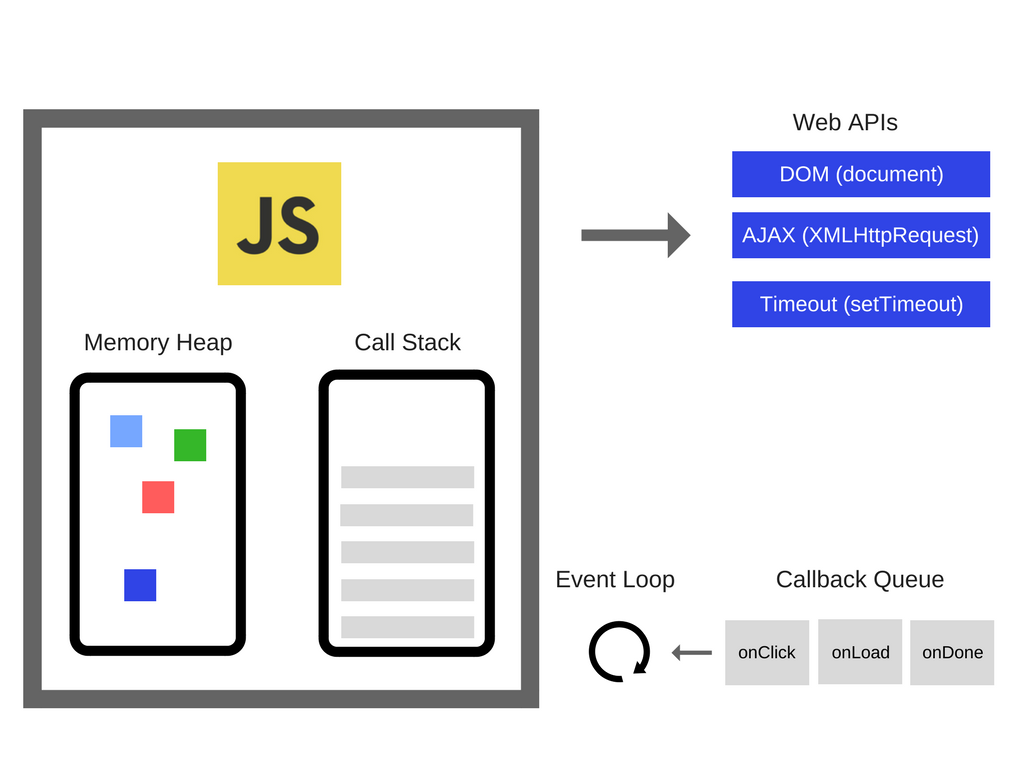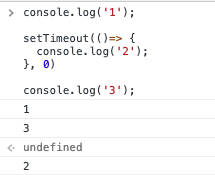How javascript Event Loop works?

Hi, the Javascript run-time environment is included in the browsers and they have extra things: the Javascript Engine, Web API, Callback Queue and Event loop.
So the browser give us some methods to use like AJAX, timeOut, DOM, and more.
Check this image:

Let’s see this code example and figure out how the Javascript Run-time environment works:
As JS go from top to bottom reading the code line by line (Synchronous), first go through line the console.log(‘1’) insert into the the Call Stack and execute that code:
console.log('1'); // 1 synchronous
setTimeout(()=> {
console.log('2');
}, 4000)
console.log('3');
/*---------JUST FOR EXPLANATION----------------*/
console.log('1'); // Inserted into the call stack, execute and removed
// CALL STACK
// WEB API
// CALLBACK QUEUE
// EVENT LOOP
Following the same example …
Then go to the next line setTimeout and insert that setTimeout code into the Call Stack:
console.log('1');
setTimeout(()=> { // 2
console.log('2');
}, 4000)
console.log('3');
/*---------JUST FOR EXPLANATION----------------*/
setTimeout(()=> {
console.log('2');
}, 4000)
// CALL STACK
// WEB API
// CALLBACK QUEUE
// EVENT LOOP
And because the timeout is part of the Web API so it triggers the Web API and say: hey setTimeout it has been call!
So, it’s removed from the Call Stack and inserted into the Web API
Following the same example …
console.log('1');
setTimeout(()=> { // 2
console.log('2');
}, 4000)
console.log('3');
/*---------JUST FOR EXPLANATION----------------*/
// CALL STACK
setTimeout, 4000 // execute this code in 4 seconds
// WEB API
// CALLBACK QUEUE
// EVENT LOOPAnd because the Call Stack is empty then the Javascript engine goes to the next line console.log(‘3’) and insert that line of code in the Call Stack and will execute that line:
Following the same example …
console.log('1');
setTimeout(()=> {
console.log('2');
}, 4000)
console.log('3'); // 3
/*---------JUST FOR EXPLANATION----------------*/
console.log('3'); // Inserted into the call stack, execute and removed
// CALL STACK
setTimeout, 4000 // execute this code in 4 seconds
// WEB API
// CALLBACK QUEUE
// EVENT LOOPThen the setTimeout is done (after 4 seconds) and removed from Web API, but the callback function that is inside the setTimeout(() => {…..} will be inserted into the Callback Queue.
Remember that a callback is a function that is to be executed after another function has finished executing.
Following the same example …
console.log('1');
setTimeout(()=> {
console.log('2');
}, 4000)
console.log('3');
/*---------JUST FOR EXPLANATION----------------*/
// CALL STACK
// WEB API
callback() // function that is inside the setTimeout
// CALLBACK QUEUE
// EVENT LOOPThe Event loop is checking all the time if the Call Stack is empty, so if is empty and nothing is running right now then the Javascript Engine is going to say: hey do we have any callbacks in the call back queue?
In this case because now the Call Stack is empty then the callback function will be moving into the Call Stack, like this:
Following the same example …
console.log('1');
setTimeout(()=> {
console.log('2');
}, 4000)
console.log('3');
/*-------------------------*/
console.log('2') // Inserted into the call stack, execute and removed
callback() // Because we are done with the callback, the will be removed
// CALL STACK
// WEB API
// CALLBACK QUEUE
// EVENT LOOPResult:

So because setTimeout method is Asynchronous it will follow in the entire process of the Call Stack, Web API, Callback Queue, Event Loop.

Even if the setTimeout have 0 milliseconds this will go through the same process, and will print the console.log(‘2’) at the end, because will be go through the entire process of the Call Stack, Web API, Callback Queue, Event Loop:
Result:

By Cristina Rojas.




